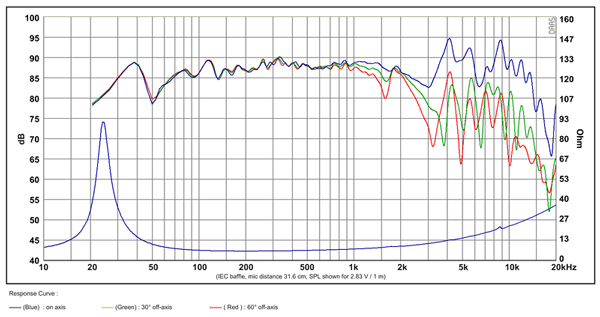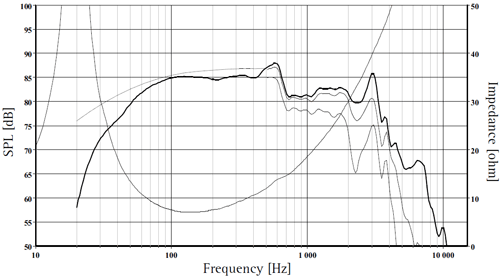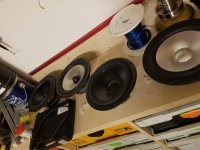I am writing this to follow up a project I completed about 6 months ago which I was trying to build an amazing mid priced 3 way speaker. I wound up using 8" woofers for the build and a total of 2 per box in paralell. I decided to order a bunch and test to find the best driver. Here are my impressions...
SB Acoustics SB23NACS45-8
SEAS Prestige L22RN4X/P
Seas Prestige CD22RN4X
SB Acoustics SB23MFCL45-8
Dayton Audio RS225-8
If you're all about graphs and charts this isn't the review for you. My process was simple. I built a box that was about 2.5 cu ft. which should be apropriate for a ported application for any of the drivers above. I cut two holes in it to accomodate any of the above drivers but without causing leaks with the smallest of the group. I cut ports in a range of sizes to be in half inch increments so that each driver could be tuned to the box volume individually. I had plenty of felt and stuffing available for damping as needed. I installed a filter that was electrically 2nd order at around 250hz. Lastly I played music and test tones at a bunch of frequencies to test them. You also have to be carefull on music to not allow the high freqency performance shape your opinion. Even with the filter some higher freq. sound comes through and wihout thinking too much it would be easy to give the best in class trophy to the driver with the widest distortion free band width.
Anyway, Here Goes...
SB Acoustics SB23NACS45-8
This was the undisputed winner of the pack. The sound was clean over the whole range of the test, the bass hit lower than I ever thought an 8" driver should be able to, and the texture was very real. I have recently done another test with 10" high end drivers and this one really shows diminishing returns to additional investment. The sensativity, box size requirment, and build quality make this driver a no brainer. I really wish I had noticed that it was also offered in black, as I hate the silver.
SEAS Prestige L22RN4X/P
Considering the range of top designs that have used this or similar OEM equivilents, this was not an impressive driver. The sound was similar if not just a bit inferrior to the much cheaper Dayton, and at the price isn't even in the same universe as the aluminum SB driver. This is a driver where it's age is showing, and the value isn't there. The build quality may have been great 20 years ago, but it's time to rethink this one.
Seas Prestige CD22RN4X
This was the weakest design of the group. This was prediced in simulation, but thought it was worth a shot. It's a design that dates back to the 90's. You can do better.
SB Acoustics SB23MFCL45-8
This is a subwoofer, but I hoped it had woofer capabilities. I was hoping that it's small 8" size and energetic top end would yield usable lower mid band performance up to a reasonable crossover point. Sadly, even in paralell the sensativity was unusable, the top end performance was lacking, and sound was slugish. On the positive side the build quality was insane for the price....
Dayton Audio RS225-8
Dayton, while not the best of the pack is still easily the best value. The sound wasn't quite on par with the SB, but it was better than the more expensive Seas drivers, and the build seemed a hair better too. If you don't want to spend a ton of money, this is the driver to beat.
SB Acoustics SB23NACS45-8
SEAS Prestige L22RN4X/P
Seas Prestige CD22RN4X
SB Acoustics SB23MFCL45-8
Dayton Audio RS225-8
If you're all about graphs and charts this isn't the review for you. My process was simple. I built a box that was about 2.5 cu ft. which should be apropriate for a ported application for any of the drivers above. I cut two holes in it to accomodate any of the above drivers but without causing leaks with the smallest of the group. I cut ports in a range of sizes to be in half inch increments so that each driver could be tuned to the box volume individually. I had plenty of felt and stuffing available for damping as needed. I installed a filter that was electrically 2nd order at around 250hz. Lastly I played music and test tones at a bunch of frequencies to test them. You also have to be carefull on music to not allow the high freqency performance shape your opinion. Even with the filter some higher freq. sound comes through and wihout thinking too much it would be easy to give the best in class trophy to the driver with the widest distortion free band width.
Anyway, Here Goes...
SB Acoustics SB23NACS45-8
This was the undisputed winner of the pack. The sound was clean over the whole range of the test, the bass hit lower than I ever thought an 8" driver should be able to, and the texture was very real. I have recently done another test with 10" high end drivers and this one really shows diminishing returns to additional investment. The sensativity, box size requirment, and build quality make this driver a no brainer. I really wish I had noticed that it was also offered in black, as I hate the silver.
SEAS Prestige L22RN4X/P
Considering the range of top designs that have used this or similar OEM equivilents, this was not an impressive driver. The sound was similar if not just a bit inferrior to the much cheaper Dayton, and at the price isn't even in the same universe as the aluminum SB driver. This is a driver where it's age is showing, and the value isn't there. The build quality may have been great 20 years ago, but it's time to rethink this one.
Seas Prestige CD22RN4X
This was the weakest design of the group. This was prediced in simulation, but thought it was worth a shot. It's a design that dates back to the 90's. You can do better.
SB Acoustics SB23MFCL45-8
This is a subwoofer, but I hoped it had woofer capabilities. I was hoping that it's small 8" size and energetic top end would yield usable lower mid band performance up to a reasonable crossover point. Sadly, even in paralell the sensativity was unusable, the top end performance was lacking, and sound was slugish. On the positive side the build quality was insane for the price....
Dayton Audio RS225-8
Dayton, while not the best of the pack is still easily the best value. The sound wasn't quite on par with the SB, but it was better than the more expensive Seas drivers, and the build seemed a hair better too. If you don't want to spend a ton of money, this is the driver to beat.
Attachments
Last edited:
I am going through a similar process as you, but am considering different drivers, driven primarily by what I have on hand. I'm looking at a ~2.3-2.5 cu ft box, and my contenders are
Peerless 830667 SLS
Peerless 830869 HDS
SB 20PFC
Currently leaning towards the SLS though I don't love their aesthetics, they model nicely and are substantially beefier than the other two.
Your evaluation is very useful, even though you didn't consider the drivers I am, I have used the rs225 in a similar application and thought it was excellent. That you think the SB is better is high praise indeed!
Peerless 830667 SLS
Peerless 830869 HDS
SB 20PFC
Currently leaning towards the SLS though I don't love their aesthetics, they model nicely and are substantially beefier than the other two.
Your evaluation is very useful, even though you didn't consider the drivers I am, I have used the rs225 in a similar application and thought it was excellent. That you think the SB is better is high praise indeed!
This subjective test is an excellent example of why people are easily fooled by subjective tests.
For instance, if someone listens to two speakers, and one speaker is louder, it will be preferred.

OP wrote that "This was the undisputed winner of the pack."

OP wrote that "This was the weakest design of the group."
Note that the former speaker is 2dB more sensitive in the midbass region. Hence, the perception that it's superior.
Note that I'm not saying that the Seas is superior. I am saying that you can't make a valid impression between two woofers unless their response curves and their levels are matched.
If this is not done, whatever is loudest will win.
For instance, if someone listens to two speakers, and one speaker is louder, it will be preferred.

OP wrote that "This was the undisputed winner of the pack."

OP wrote that "This was the weakest design of the group."
Note that the former speaker is 2dB more sensitive in the midbass region. Hence, the perception that it's superior.
Note that I'm not saying that the Seas is superior. I am saying that you can't make a valid impression between two woofers unless their response curves and their levels are matched.
If this is not done, whatever is loudest will win.
I used a crossover to help correct for energy rise and to cross over around 250. I didn't care about their midrange performance as I was building a 3 way. For low Freq, I just kept turning the volume up to see if they were even able to hit hard. If the driver isn't capable of delivering at any volume, it doesn't matter if they are level matched. Lastly, I walked around for low freq. testing as the room modes move the peak spots around.
If the driver isn't capable of delivering at any volume, it doesn't matter if they are level matched.
Incorrect.
If you're not matching their SPL and response, you will end up preferring whichever is louder.
This is one of the reasons that a lot of people prefer drivers with high distortion; the harmonic distortion makes it sound louder.
I appreciate that you purchased drivers and invested the time to make a subjective comparison, but your conclusions about the SEAS aren't reliable because the curves weren't matched.
Patrick's critiques are exactly right.
Perhaps try to use something like Dirac Live to auto-eq the bandwidth of interest, and then level match each one.
Room modes will affect each one the same.
I used a crossover to help correct for energy rise and to cross over around 250.
Perhaps try to use something like Dirac Live to auto-eq the bandwidth of interest, and then level match each one.
Lastly, I walked around for low freq. testing as the room modes move the peak spots around.
Room modes will affect each one the same.
I think you guys are misunderstanding in thinking that I was looking for advice. This was only intended to convey information.
The project is finished and the process worked well. I more than achived the results I was after. I even prefer the low end bass to high end speakers using more expensive drivers, like the Sony SS-AR1 or Wilson Sasha.
The project is finished and the process worked well. I more than achived the results I was after. I even prefer the low end bass to high end speakers using more expensive drivers, like the Sony SS-AR1 or Wilson Sasha.
Thanks. Working a similar problem.
I recently asked an extremely experienced and capable speaker designer almost this exact question. he said - essentially - "go with the Dayton it is fine". And he knows that my design is based around diamond tweeter and 5" Be midrange - (I'm not aiming at cheap, and looking for 8 inchers to cover to 600 hz.)
I recently asked an extremely experienced and capable speaker designer almost this exact question. he said - essentially - "go with the Dayton it is fine". And he knows that my design is based around diamond tweeter and 5" Be midrange - (I'm not aiming at cheap, and looking for 8 inchers to cover to 600 hz.)
At the HiFiCompass website, the SB Acoustics SB23NACS45-8 measured very well for harmonic distortion in the bass 20 - 250 Hz range. See the 'HD Frequency Response (20mm Distance)' at the link below. Unfortunately, the other woofers mentioned are not tested on the site.
SB Acoustics SB23NACS45-8 | HiFiCompass
SB Acoustics SB23NACS45-8 | HiFiCompass
While I am in agreement that levels must be matched, trying to correct and/or match response curves is counter-intuitive since the frequency response of each driver, over a specific band, is part of what you are audibly comparing.
Surely the same target response is desired irrespective of which driver is selected? The design will equalise any differences in raw response between the drivers. I would not be comparing the raw frequency response of the drivers, I would only want to know if the response can be easily manipulated to hit my target.
Agree...
But in reality that requires you to
-1- measure the drivers actual performance, and
-2- build the crossover.
I am of the opinion that you just have to do that to make a meaningful statement about how applicable a driver will be in a system.
Issues such as breakup and out of band response are critical in applying a driver in a system. How these are managed in the crossover makes or breaks the system.
That said, the OP enjoyed the process and shared subjective results with the caveat that they were TRULY subjective! I'd prefer in a hobbyist that than a pure paper exercise!
But in reality that requires you to
-1- measure the drivers actual performance, and
-2- build the crossover.
I am of the opinion that you just have to do that to make a meaningful statement about how applicable a driver will be in a system.
Issues such as breakup and out of band response are critical in applying a driver in a system. How these are managed in the crossover makes or breaks the system.
That said, the OP enjoyed the process and shared subjective results with the caveat that they were TRULY subjective! I'd prefer in a hobbyist that than a pure paper exercise!
I think you guys are misunderstanding in thinking that I was looking for advice.
I think you misunderstand the intended audience for the comments. Your samplings may have gotten you someplace you like, but they are not transferable to any other listener or any other circumstance.
- Status
- This old topic is closed. If you want to reopen this topic, contact a moderator using the "Report Post" button.
- Home
- Loudspeakers
- Multi-Way
- Review of 5 Mid Priced 8" Woofers
